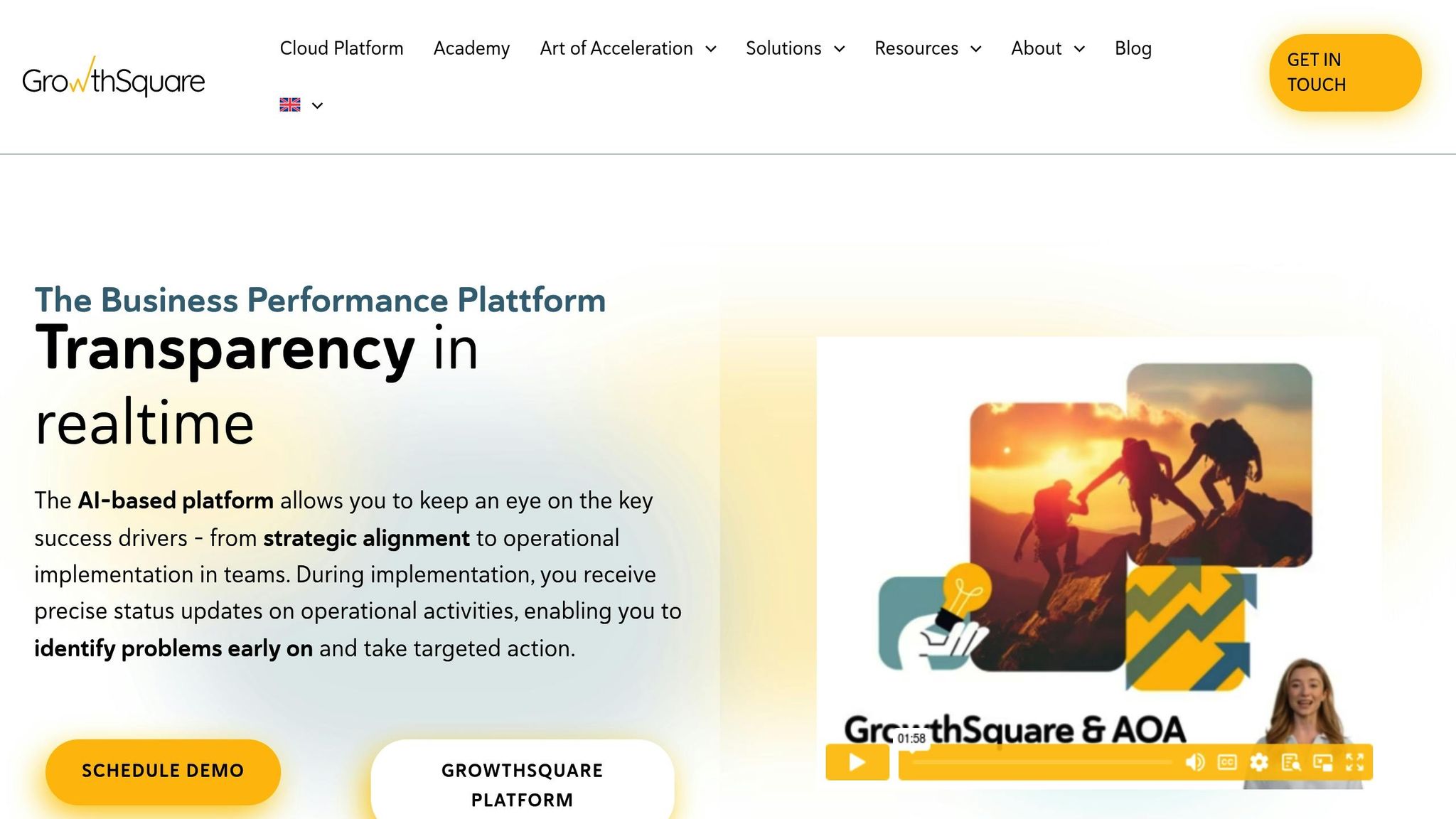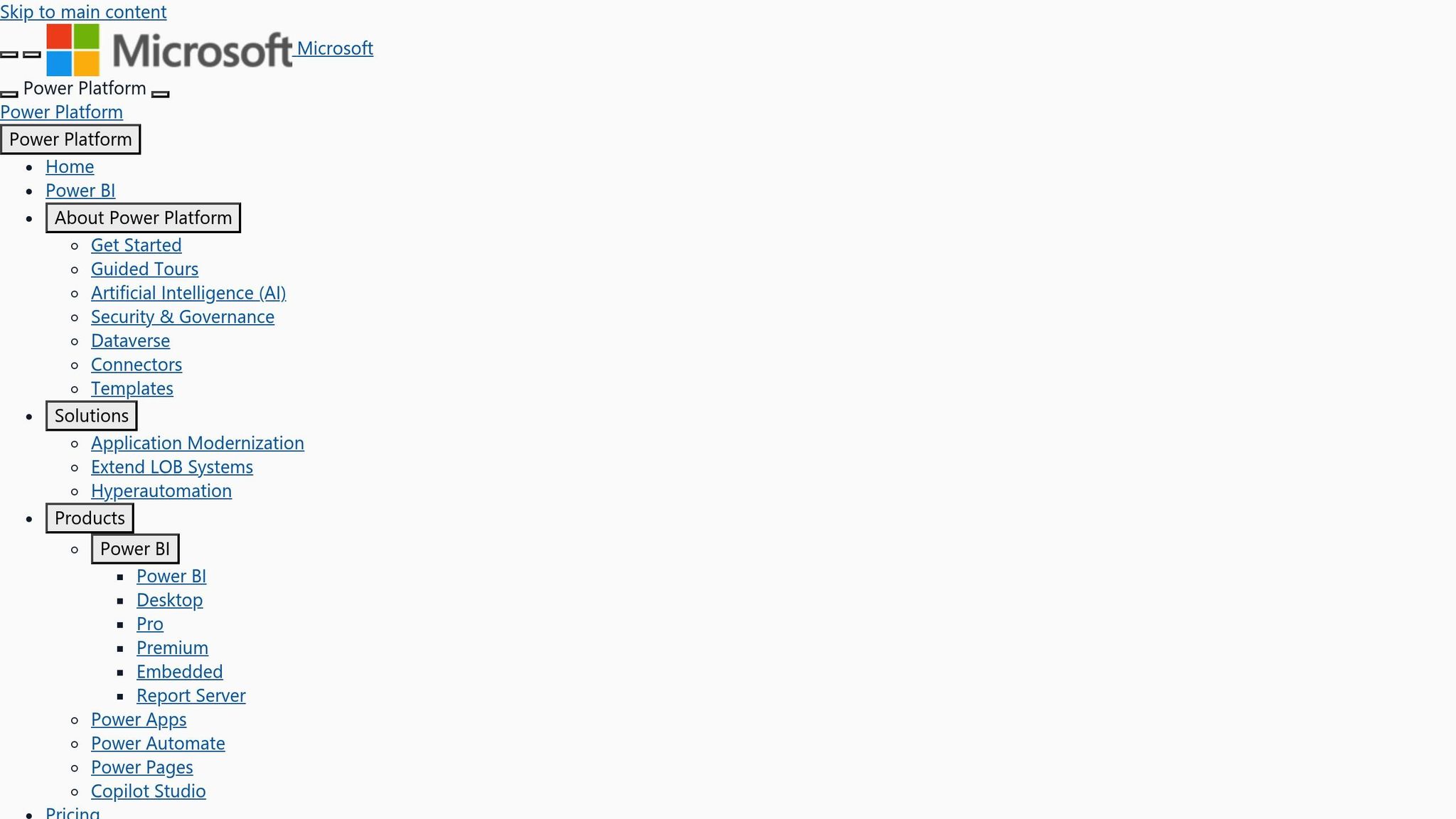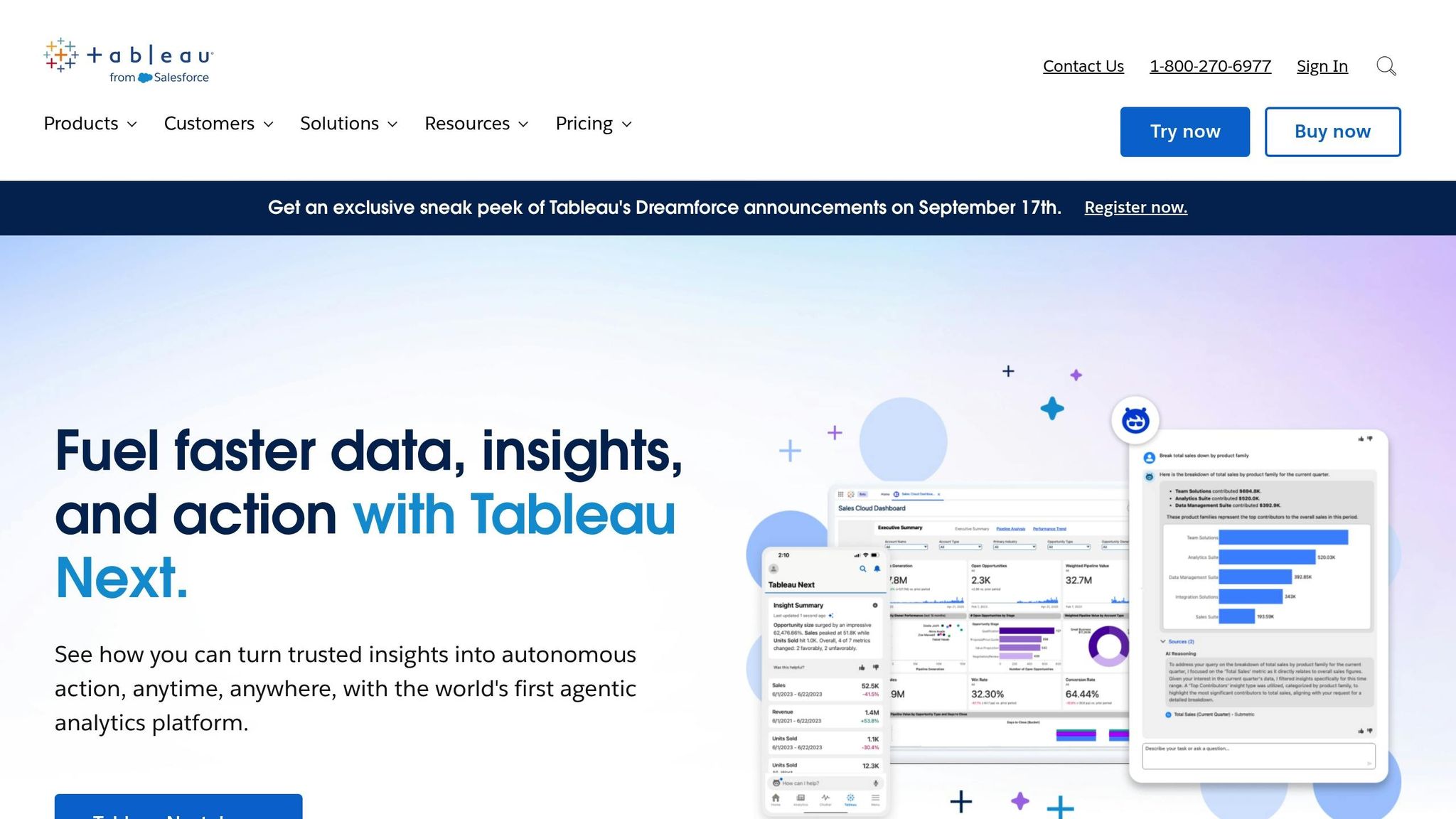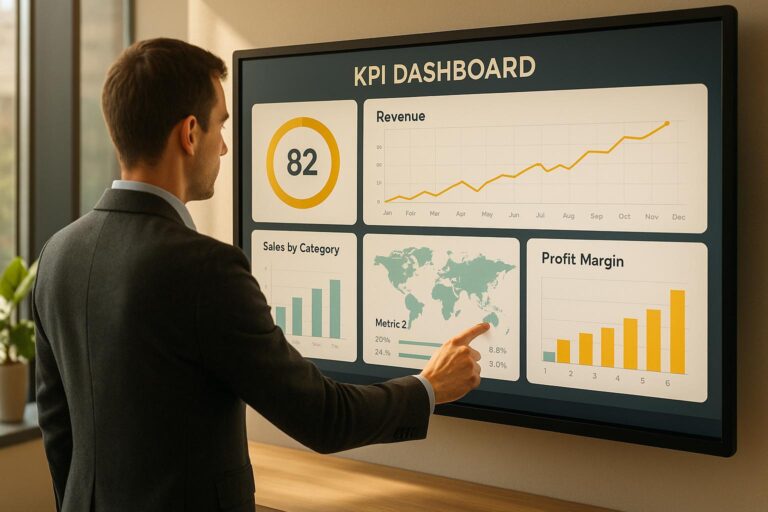German businesses need tools that deliver precise, real-time insights into their key performance indicators (KPIs). Static dashboards and monthly reports no longer suffice in today’s fast-paced, compliance-driven environment. This article explores three AI-powered platforms – GrowthSquare, Microsoft Power BI, and Tableau – that enable interactive KPI drill-downs, helping organizations monitor performance, address challenges, and meet regulatory standards.
Key Takeaways:
- GrowthSquare: Focuses on real-time monitoring, predictive controlling, and compliance with German regulations. Its usage-based pricing and minimal technical barriers make it accessible for broader teams.
- Microsoft Power BI: Offers advanced analytics, seamless data integration, and GDPR-compliant storage options. Its Azure Machine Learning integration enhances forecasting capabilities.
- Tableau: Known for its user-friendly visual analytics, live data connections, and forecasting tools. It supports German data residency requirements and provides robust compliance features.
Quick Comparison:
| Criteria | GrowthSquare | Microsoft Power BI | Tableau |
|---|---|---|---|
| Real-time Data | AI-driven, EUR (€), DD.MM.YYYY | Live connections, secure gateways | Live connections, large datasets |
| Drill-down Features | Context-aware, user-friendly | Advanced drill-through, bookmarking | Click-based, parameter controls |
| Predictive Analytics | Predictive controlling, AOA | Azure ML integration, Quick Insights | Built-in forecasting, regression |
| Compliance | Audit-proof archiving, GDPR | GDPR, row-level security | Audit logs, data lineage |
| Pricing | Usage-based | Per-user licensing | Per-user licensing |
Each tool provides unique advantages for German companies, from compliance features to predictive analytics. Select the one that aligns with your organizational needs, technical expertise, and budget.
How to: Create a real-time KPI dashboard
1. GrowthSquare

GrowthSquare is an AI-powered platform that combines real-time monitoring with predictive analytics to provide actionable insights for better decision-making. Founded by industry professionals, it takes a human-focused approach by incorporating human factors into performance assessments. This makes it especially valuable for German organisations, where precision and strategic alignment are critical.
Real-time Data Integration
GrowthSquare pulls real-time data from various business systems and formats it automatically in EUR (€), DD.MM.YYYY, and metric units, making it easy to understand and use. For German manufacturing companies, this feature is particularly useful. Production managers, for instance, can track efficiency metrics as they happen, rather than waiting for end-of-shift summaries.
The platform’s standardised data structure ensures consistency across departments, creating a unified database that supports transparency and collaboration. This reduces data silos and encourages teamwork – key for modern German enterprises. On top of that, the platform offers interactive drill-down tools that give users deeper insights into their data.
Interactive Drill-down Capabilities
GrowthSquare’s interactive drill-down feature lets users explore KPI dashboards in detail by clicking through to underlying data. Managers can break down results by department, time period, or operational metrics, helping them quickly pinpoint issues.
This tool is especially useful for understanding cross-departmental dependencies, making it easier to allocate resources and make informed decisions. The platform’s intuitive interface means minimal training is required, so teams with varying technical skills can adopt it quickly.
With AI-driven data precision, users can trust the accuracy of the information they uncover during their analysis. This is a major advantage for German businesses, where accuracy is non-negotiable. These capabilities also set the stage for better forecasting and strategic planning.
Predictive Analytics
GrowthSquare uses predictive controlling to generate realistic forecasts based on historical data and live inputs. This helps German organisations anticipate trends and set achievable performance goals.
The platform’s Art of Acceleration (AOA) methodology combines transparent KPI tracking with predictive insights, enabling faster execution of strategies without compromising on long-term objectives. This approach boosts performance while keeping goals realistic and manageable.
Additionally, automated market data analysis strengthens the platform’s forecasting abilities, allowing businesses to respond quickly to changing conditions. This is especially helpful for German exporters, who often face fluctuating international markets while striving to maintain top-notch domestic operations.
Compliance and Audit-proofing
Beyond its real-time and predictive features, GrowthSquare ensures regulatory compliance with its audit-proof archiving system. This feature provides traceable, tamper-proof storage and controlled access to critical data, meeting Germany’s strict regulatory standards, including GDPR.
The platform keeps detailed logs of KPI changes and user actions, creating a transparent audit trail for both internal and external reviews. Its audit-proof data management eliminates compliance worries, making it easier to navigate digital transformation projects.
German businesses also benefit from the platform’s ability to clearly distinguish between data versions while maintaining consistent formatting across the organisation. This structured system allows compliance officers to locate and verify information quickly during audits, streamlining the entire process.
2. Microsoft Power BI

Microsoft Power BI stands out with its advanced KPI drill-down features, AI-powered analytics, and an intuitive interface that supports in-depth performance analysis across various business units.
Real-time Data Integration
Power BI ensures data is seamlessly aligned with German standards, offering real-time streaming and secure data gateway solutions. With features like DirectQuery, dashboards stay updated with live database connections, providing accurate insights at any moment. The secure data gateway establishes safe connections between cloud services and on-premises systems, addressing concerns about data sovereignty. Additionally, its extensive range of data connectors makes it versatile for different business environments.
Interactive Drill-down Capabilities
Power BI’s drill-through feature enables users to move from high-level KPI summaries to detailed data views effortlessly. Cross-filtering ensures that when a specific data point is selected, related visuals update automatically, creating a cohesive and interactive experience. The bookmarking tool further enhances collaboration by allowing users to save and share specific drill-down states for group analysis.
Predictive Analytics
With Azure Machine Learning integration, Power BI offers tools for forecasting trends, spotting anomalies, and modeling scenarios through what-if parameters. These AI-driven insights assist businesses in anticipating demand changes and managing inventory more effectively. The Quick Insights feature scans datasets to uncover patterns, correlations, and outliers, providing valuable input for strategic planning.
Compliance and Audit-proofing
Power BI addresses regulatory needs with German data residency options and GDPR-compliant storage in local data centres. Detailed audit logs track user activity, including data changes and report sharing, ensuring transparency during reviews. Row-level security enables organisations to restrict data access based on roles, protecting sensitive KPI information. Certified datasets standardise KPI definitions across the organisation, ensuring consistency and simplifying audits. These compliance measures, paired with its analytical tools, make Power BI a strong contender as we delve deeper into the comparison of tools.
sbb-itb-4b82ce2
3. Tableau

Tableau provides a powerful way to analyze KPIs through its user-friendly visual analytics, helping German businesses make informed decisions with ease.
Real-time Data Integration
Tableau ensures your KPI dashboards are always up-to-date by offering live data connections. It integrates seamlessly with databases, cloud platforms, and enterprise systems, refreshing data automatically to maintain accuracy. For German organizations, on-premises deployment options address local data residency laws while still enabling real-time updates. The platform’s data engine handles large datasets effortlessly, making it ideal for monitoring high-frequency KPIs. This real-time connectivity allows businesses to stay on top of their performance metrics at all times.
Interactive Drill-down Capabilities
With Tableau, users can dive deep into their data, moving from high-level KPIs to detailed insights with just a few clicks. Its drill-down and drill-through features let you navigate across dashboards and data sources while keeping the context intact. Highlight actions connect visualizations, so selecting one data point updates related views automatically. Plus, parameter controls make it easy to filter by timeframes, business units, or other criteria – no technical skills required. This is particularly useful for German manufacturers managing complex KPIs across multiple plants or product lines.
Predictive Analytics
Tableau goes beyond real-time monitoring by incorporating predictive analytics directly into dashboards. Its forecasting tools analyze past performance to predict future trends, helping businesses in Germany prepare for seasonal shifts or market changes. Built-in statistical tools enable regression analysis, correlation checks, and outlier detection. The Ask Data feature even supports queries in German, making advanced analytics accessible to everyone, even those without technical expertise.
Compliance and Audit-proofing
Tableau meets Germany’s strict regulatory standards by providing detailed audit logs that track data access, filters, and exports. Row-level security ensures sensitive KPI data is only visible to authorized users, following organizational hierarchies and governance policies. The platform also documents data lineage, offering transparency from source to final KPI calculations – a critical feature for audits. Additional tools like data anonymization and user consent management further enhance compliance, while deployment options in German data centers address data residency concerns.
Advantages and Disadvantages
Building on the detailed tool profiles, let’s dive into the key advantages and disadvantages of these solutions. These comparisons can help German organisations make informed decisions when selecting the right tool for their needs.
GrowthSquare takes a clear lead with its emphasis on strategic alignment and user-focused execution. Its Art of Acceleration methodology provides a structured framework for implementing strategies that go far beyond standard data visualisation. Additionally, its audit-proof archiving ensures compliance with German regulatory requirements – a critical feature for many organisations.
On the other hand, traditional analytics platforms excel in data visualisation and customisation. They handle complex datasets with ease and offer powerful statistical tools. However, these platforms often present a steep learning curve, especially for non-technical users, making them less accessible for broader teams.
Here’s how the tools compare across some key criteria:
| Criteria | GrowthSquare | Other Platforms |
|---|---|---|
| Real-time Data Integration | AI-driven, real-time integration | Strong live connections |
| Interactive Drill-down Capabilities | Context-aware drill-downs tied to strategic goals | Advanced drill-through features with parameter controls |
| Predictive Analytics | Built-in predictive controlling | Statistical forecasting tools |
| Compliance/Audit-proofing | Designed for audit-proof archiving | Customisable audit logs with detailed access settings |
These comparisons reveal clear trade-offs. GrowthSquare’s pricing model is usage-based, which can be more flexible compared to the per-user licensing of traditional platforms. The latter can quickly drive up costs when deployed across multiple departments.
Another major difference lies in implementation complexity. GrowthSquare’s user-friendly, people-first approach lowers technical barriers, allowing business users to adopt the platform with minimal IT support. Traditional platforms, however, often demand significant technical expertise, which can place an additional burden on organisations focused on processes rather than technology.
When it comes to data governance, GrowthSquare offers shared reality insights that identify misalignments early, helping teams address discrepancies in KPI interpretations across departments. Traditional platforms, while offering detailed access controls, often require manual configuration to achieve similar results.
For organisations looking at long-term strategic value, GrowthSquare supports a comprehensive, people-focused approach to strategy execution. In contrast, many other platforms prioritise exploratory data analysis and may require additional tools to manage strategies effectively.
Conclusion
When selecting an AI KPI drill-down tool, it’s essential to focus on your strategic goals and the need for real-time transparency.
GrowthSquare stands out by combining strategic alignment with actionable insights. Its Art of Acceleration methodology, audit-proof data management, and predictive controlling make it a practical choice for businesses aiming to align their strategy with execution. Unlike traditional platforms that lean heavily on data exploration and statistical analysis – often requiring extensive IT resources – GrowthSquare simplifies the process.
For German manufacturers and medium-sized enterprises, GrowthSquare’s intuitive design allows teams to engage directly with strategic KPIs without needing advanced technical expertise. Its shared reality insights address a frequent pain point: the risk of departments interpreting KPIs differently, which can lead to misalignments. By identifying these issues early, businesses can act quickly to stay on course.
Another advantage is GrowthSquare’s flexible, usage-based pricing model, which avoids the high costs associated with per-user licensing found in many traditional tools.
As you consider your options, think about your long-term objectives, technical capabilities, and compliance requirements. GrowthSquare’s focus on real-time transparency and people-driven execution offers German businesses a reliable solution for agile decision-making. It’s a platform designed to enhance KPI analysis and improve overall performance in today’s data-driven environment.
FAQs
What makes GrowthSquare’s ‘Art of Acceleration’ methodology unique compared to traditional frameworks like OKRs?
GrowthSquare’s ‘Art of Acceleration’ (AOA) methodology brings a fresh perspective by putting employees at the center and encouraging collaboration. It focuses on building a shared understanding of strategic objectives, which sets it apart from more rigid frameworks like OKRs. Instead of emphasizing strict goal-setting and tracking, AOA prioritizes flexibility and teamwork to align teams around common goals.
This approach boosts productivity and promotes transparency, helping organisations achieve steady growth while making smarter decisions. With tools like real-time monitoring, predictive controls, and secure data management, AOA ensures smooth strategy execution and delivers measurable improvements in business performance.
What makes GrowthSquare’s usage-based pricing model more beneficial than traditional per-user licensing?
GrowthSquare’s usage-based pricing model brings several advantages compared to the more traditional per-user licensing approach. The standout benefit? Costs are directly tied to how much you actually use, meaning you only pay for what you truly need. This makes it easier for businesses to manage expenses, especially those with fluctuating or scalable needs, and can even speed up purchasing decisions and adoption processes.
Another big plus is the freedom it provides for testing and trying out new features or strategies. Teams can experiment without being locked into fixed user numbers, which can spark fresh ideas and new approaches. On top of that, it promotes better customer satisfaction and loyalty, as businesses immediately see value without feeling like they’re overspending. For companies in Germany or operating across borders, this pricing model aligns perfectly with the demand for transparent and efficient budgeting that scales as needed.
How does GrowthSquare comply with German regulations, like GDPR, while delivering real-time KPI insights?
GrowthSquare operates in full alignment with Germany’s stringent regulatory standards, including GDPR. It ensures full data traceability, secure, tamper-proof storage, and restricted access controls, providing both security and transparency while adhering to legal obligations.
The platform’s solid infrastructure is built to safeguard sensitive data, allowing businesses to track KPIs in real time without breaching compliance. By prioritizing privacy and accountability, GrowthSquare meets Germany’s high regulatory demands with precision.
